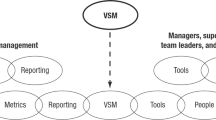Abstract
This paper proposes a practical framework for choosing among different lean-based improvement programs in a one-machine environment and applies it in a company in the aeronautics industry. For the studied environment, i.e., a single machine and machining process bottleneck, the application of the proposed framework resulted in a potential 84.63 % improvement in lead time, which can be obtained by improving the mean time between failures by 1373 % and requires an effort of 5880 h. Alternatively, a 34.76 % reduction in lead time is also possible through a 1960-h investment in labor; this improves the coefficient of variation of repair time by 72 %. It is believed that the model proposed here can help managers in practice to quantify and choose between different options of lean-based improvement programs in single-machine or single-cell environments with flowshop standards and a predominant machine, which is typical of lean manufacturing systems.
Similar content being viewed by others
References
Agrell PL, Wikner J (1996) An MCDM framework for dynamics systems. Int J Econ 45:279–292
Almin MA, Karim MA (2013) A time-based quantitative approach for selecting lean strategies for manufacturing organisations. Int J Prod Res 51(4):1146–1167
Barad M, Dror S (2008) Strategy maps as improvement paths of enterprises. Int J Prod Res 46(23):6627–6647
Barratt M, Choi TY, Li M (2011) Quantitative case studies in operational management: trends, research outcomes, and future research implications. J Oper Manag 29:329–342
Danese P, Romano P, Vinelli A (2006) Sequences of improvement in supply networks: case studies from the pharmaceutical industry. Int J Oper Prod Manag 26(11):1199–1222
Forrester JW (1961) Industrial dynamics. Productivity Press, Portland, 464p
Godinho Filho M (2012) Effect of lot-size reduction and continuous improvement programmes on work in process and utilisation: a study for single-machine and flowshop environments. Int J Logist-Res App 15(5):285–302
Godinho Filho M, Uzsoy R (2011) The effect of shop floor continuous improvement programs on the lot size–cycle time relationship in a multi-product single-machine environment. Int J Adv Manuf Technol 52:669–681
Godinho Filho M, Uzsoy R (2013) The impact of simultaneous continuous improvement in setup time and repair time on manufacturing cycle times under uncertain conditions. Int J Prod Res 51(2):447–464
Godinho Filho M, Guimarães AA, Oprime PC (2013) Guiding improvement programs towards LT reduction in a single-machine environment. Int J Adv Manuf Technol 66(9–12):1987–1998
Grutter AW, Field JM, Faull NHB (2002) Work team performance over time: three case studies of South African Manufacturers. J Oper Manag 20(5):641–657
Heijnen P, Lukszo Z (2006) Continuous improvement of batch wise operation—a decision support framework. Prod Plan Control 17(4):355–366
Hong J, Hayya JC (1995) Joint investiment in quality improvement and setup reduction. Comput Oper Res 22(6):567–574
Hong J, Xu SH, Hayya JC (1993) Process quality improvement and setup reduction in dynamic lot-sizing. Int J Prod Res 31(11):2693–2708
Hopp WJ, Spearman ML (2008) Factory physics: foundations of manufacturing management, 3rd edn. McGraw-Hill Higher Education, Nova York, 720p
Hopp WJ, Iravani SMR, Shou B (2007) A diagnostic tree for improving prodution line performance. Prod Oper Manag 16(1):77–92
Hu G, Wang L, Fetch S, Bidanda B (2008) A multi-objective model for project portfolio selection to implement lean an Six Sigma concepts. Int J Prod Res 46(23):6611–6625
Jaber MY, Bonney M (2003) Lot sizing with learning and forgetting in setups and in product quality. Int J Prod Econ 83:95–111
Khang DB, Myint YM (1999) Time, cost and quality trade-off in project management: a case study. Int J Proj Manag 17(4):249–256
Liker JK (2004) The Toyota way: 14 management principles from the world’s greatest manufacturer. McGraw-Hill, New York
Mauri F, Garetti M, Gandelli A (2010) A structured approach to process improvement in manufacturing systems. Prod Plan Control Manag Oper 21(7):695–717
Mohanty RP, Deshmukh SG (2001) Reengineering of materials management system: a case study. Int J Prod Econ 70:267–278
More RA (1988) Supplier/User interfacing in the development and adoption of new hardware/software systems: a framework for research. IEEE Trans Eng Manag 35:3
Oliva R, Watson N (2011) Cross-functional alignment in supply chain planning: a case study of sales and operations planning. J Oper Manag 29:434–448
PORTEUS EL (1986) Optimal lot sizing, process quality improvement and setup cost reduction. Operations Research, 34: 137-144.
Ramesh V, Kodali R (2012) A decision framework for maximizing lean manufacturing performance. Int J Prod Res 50(8):2234–2251
Sezen B, Karakadilar IS, Buyukozkan G (2013) Propositions of a model for measuring adherence to lean practices: applied to Turkish automotive part suppliers. Int J Prod Res 50(14):3878–3894
Stenger AJ (1996) Reducing inventories in a multi-echelon manufacturing firm—a case study. Int J Prod Econ 45:239–249
Sterman JD (2000) Business dynamics: systems thinking and modeling for a complex world. Irvwin McGraw- Hill, Boston, 982p
Suri R (1998) Quick response manufacturing: a companywide approach to reducing LTs. Productivity Press, Portland, 545p
Suri R (2010) It’s about time: the competitive advantage of quick response manufacturing. Productivity Press, New York
Thawesaengskulthaia N, Tannocka JDT (2008) A decision aid for selecting improvement methodologies. Int J Prod Res 46(23):6721–6737
Treville SD et al (2004) From supply chain to demand chain: the role of LT reduction in improving demand chain performance. J Oper Manag 21:613–627
Womack JP, Jones DT (1998) A mentalidade Enxuta nas empresas. Campus
Wu Z, Choi TY (2005) Supplier–supplier relationships in the buyer–supplier triad: building theories from eight case studies. J Oper Manag 24(1):27–52
Yin R (1994) Case study research, 2nd edn. Sage Publications, Thousand Oaks
Author information
Authors and Affiliations
Corresponding author
Rights and permissions
About this article
Cite this article
Godinho Filho, M., Barco, C.F. A framework for choosing among different lean-based improvement programs. Int J Adv Manuf Technol 81, 183–197 (2015). https://doi.org/10.1007/s00170-015-7181-4
Received:
Accepted:
Published:
Issue Date:
DOI: https://doi.org/10.1007/s00170-015-7181-4




